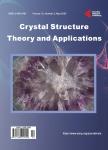Synthesis, Characterization and Thermal Analysis of an Organic-Inorganic Hybrid Salt Involving <i>Trans</i>-Diaquabis(oxalato-κ<sup>2</sup><i>O</i><sup>1</sup>,<i>O</i><sup>2</sup>)chromate(III) Complex Anion with Piperidinium as Counter Cation
Synthesis, Characterization and Thermal Analysis of an Organic-Inorganic Hybrid Salt Involving <i>Trans</i>-Diaquabis(oxalato-κ<sup>2</sup><i>O</i><sup>1</sup>,<i>O</i><sup>2</sup>)chromate(III) Complex Anion with Piperidinium as Counter Cation作者机构:Department of Inorganic Chemistry Faculty of Science University of Yaounde I Yaounde Cameroon Department of Chemistry Faculty of Science University of Dschang Dschang Cameroon Department of Chemistry Higher Teachers’ Training College University of Maroua Maroua Cameroon Department of Chemistry Higher Teachers’ Training College University of Yaounde I Yaounde Cameroon CRM2 Université de Lorraine CNRS Nancy France
出 版 物:《Crystal Structure Theory and Applications》 (晶体结构理论与应用(英文))
年 卷 期:2020年第9卷第2期
页 面:36-47页
学科分类:081704[工学-应用化学] 07[理学] 08[工学] 0817[工学-化学工程与技术] 070303[理学-有机化学] 0703[理学-化学]
主 题:Hybrid Salt Diaquabis(oxalato)chromate(III) Complex Crystal Structure Layered Structure Spectroscopy Thermal Analysis
摘 要:A new organic-inorganic hybrid salt pipéridinium trans-diaquabis(oxalato)- chromate(III) tetrahydrate, (C5H10NH2)[Cr(C2O4)2(H2O)2]·4H2O (1), has been synthesized in water and characterized by FTIR and UV-Vis spectroscopies, elemental and thermal analyses and by single-crystal X-ray diffraction. 1 crystallizes in the orthorhombic non-centrosymmetric space group Cmc21 with the unit cell parameters a = 7.4329(3), b = 9.9356(5), c = 23.6756(11) Å, α = β = γ = 90°, V = 1748.45(14) Å3 and Z = 4. The structure of 1 consists of [Cr(C2O4)2(H2O)2]- mononuclear anions, piperidinium cations and uncoordinated water molecules. The CrIII ion in the complex [Cr(C2O4)2(H2O)2]- is coordinated in a slightly distorted octahedral environment by four O atoms from two chelating oxalate dianions in the equatorial plane, and two O atoms from trans-coordinated water molecules occupying the apical positions. In the crystal, N-H···O and O-H···O hydrogen bond interactions connect the components into a 3-D framework. The IR spectrum of 1 is consistent with the presence of the various molecular building constituents, namely oxalato and aqua ligands, piperidinium cations and solvent water molecules. The UV-Vis spectrum shows two absorption bands around 564 and 416 nm which are compatible with an anionic chromium(III) complex in an octahedral environment. Thermal analysis shows a three-step decomposition of 1, leading to formation of a metal oxide residue.



